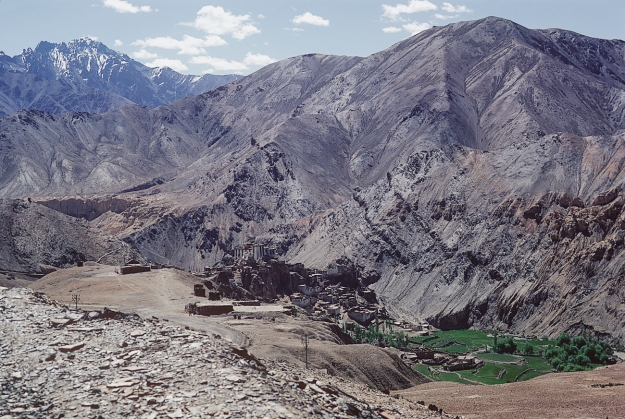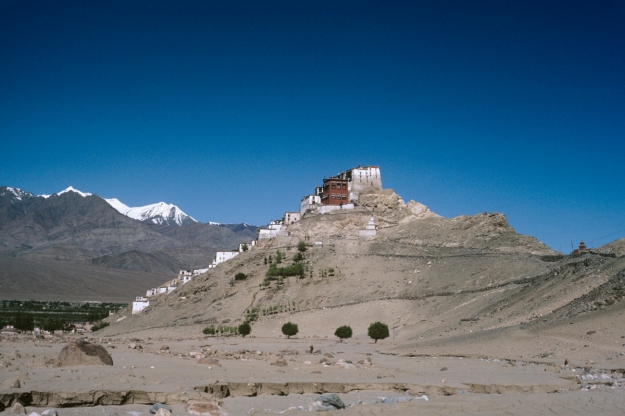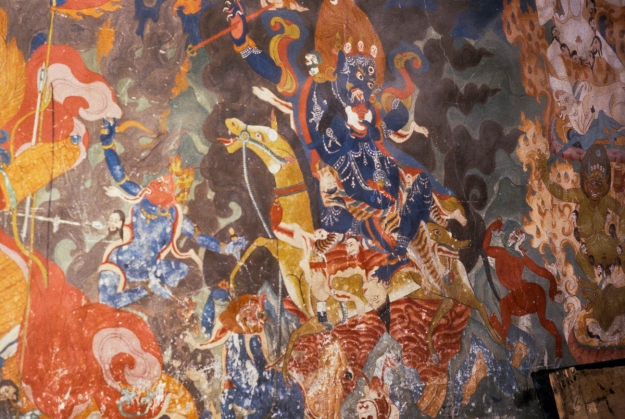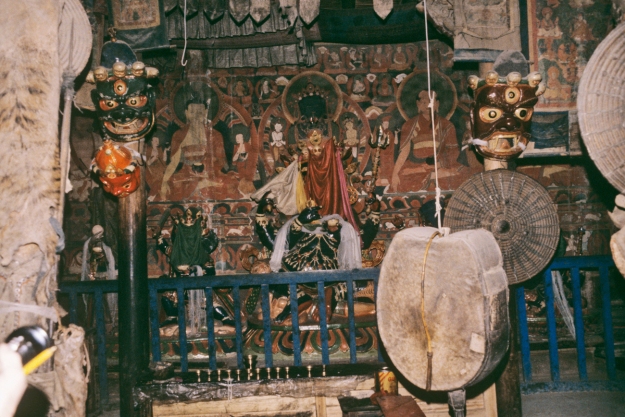The physical landscape of the Himalayas can be rugged, challenging, insulating, and endearing. Home to centuries of earnest practitioners as well as Orientalist projections, those who inhabit these mountains have long negotiated their relationship to their environment in spiritual and religious terms.

Distant view, Lamayuru Monastery, Leh, Ladakh. Photo processed July 1980. Bernier Archive #vrc_20150618_213.
Monasteries were by necessity separated from the community at large, keeping away secular influences as much as safeguarding the wealth that lay within. Many were placed on hillocks or other promontories which allowed residents to more easily survey and monitor the environment.

Distant view, Spituk Monastery. Slide processed August 1983. Bernier Archive #vrc_20150618_200.
Often there will be some sort of monument that demarcates the boundaries of the complex; in the case below, a chorten (Skt. stupa), acts as a gateway.

From Ron’s notebook: “Ladakh. Chorten on descent from Leh hill”. Slide processed July 1980. Bernier Archive #vrc_20150618_174.
But not all demarcations are physical structures; many times there are successive layers of protective imagery in the forms of murals and sculptures. In Himalayan Buddhism, a frequently encountered set of such figures is the Four Guardian Kings, two of whom are visible in the mural below. Each of the kings has a specific iconography and is associated with one of the four cardinal directions. Taken together, they protect and sustain sacred space in a conceptual sense, clearing the area of any negative forces that could impact the practitioner. (For more on the Four Guardian Kings, see the associated entry at Himalayan Art Resources.) Images such as these are public, exoteric, and easily seen. However, as a person moves inside the temple, the content of the imagery changes markedly.

20th century mural of Vaishravana, Guardian King of the North, and Virupaksha, Guardian King of the West, Boudha, Kathmandu, Nepal. Slide processed August 1989. Bernier Archive #vrc_20150618_191.
Inside, murals tend to shift to show a number of themes that are more accessible to an initiated audience, and often require specialist knowledge, initiation, or understanding. Such themes include lineage figures particular to a specific tradition (such as the Drukpa Kagyu masters in the scene below), biographical scenes from the life of the Buddha or other advanced practitioner, visualization processes (such as Pure Lands), and higher level meditational deities.

Mural of Drigung Kagyu lineage masters, Phyang Monastery, Ladakh. Photo processed July 1980. Bernier Archive #vrc_20150618_214.
Below is a form of Shri Devi (Palden Lhamo) known as Magzor Gyalmo, associated with the Gelug or Yellow Hat tradition of Himalayan Buddhism. Two of her attendants, Simhamukha (lion-faced; Sengdongma) and Makaramukha (makara-faced) are visible just below her and to the sides. Magzor Gyalmo is distinguished by having two arms, and a lion emerging from the earring in her right ear and a snake in the earring in her left ear (which is reversed from other forms of Shri Devi). The blue two armed figure holding the kila (phurba) and curved knife is unidentified. To the right are Yellow Yama and White Yama, most likely two of five attendants to a main Yama image not visible in this photo.
Shri Devi is a comparatively more complex deity, and is generally not an exoteric figure. Her practices are restricted to those individuals who receive an initiation from a qualified master, and in all her forms, she serves as a high level protector to Himalayan Buddhist practitioners and traditions.

Mural of Magzor Gyalmo and retinue figures of Yama, Thikse Monastery, Ladakh. Slide processed July 1980. Bernier Archive #vrc_20150618_197.
And the sacred space is not limited to painting alone; as mentioned elsewhere, the shrine as a whole is constituted of complex and multilayered imagery that combine to represent history and practice, as seen in the image below in its traditional armor, masks for ritual dance, animal skins, sculpted protective deities (described in more detail below the image), musical instruments, paintings, and banners.

Interior view of shrine and murals, Phyang, Leh, Ladakh. Slide processed July 1980. Bernier Archive #vrc_20150618_167.
The main image of the Phyang shrine is seated, solitary four-armed Mahakala (Caturbhuja Mahakala; Gonpo Chagzhipa) that is primarily propitiated by Kagyu traditions of Himalayan Buddhism. His upper right hand holds a sword, upper left a trident, primary right the kartrika (flaying knife), and primary left hand the kapala (skull bowl). To the left of the main figure is a retinue figure/attendant to the main image, who is also dark blue in color, however is standing holding an upraised sword in the right hand and cradling the kapala in his left. Another standing attendant can be seen further to the left, holding a mirror and a kapala. The murals depict Shakyamuni Buddha with his two primary attendants, Shariputra and Maugalyayana; the central mural images are of Vajradhara (Dorje Chang) and his two standing bodhisattva attendants; and to the right is an unidentified Drigung Kagyu master with two attendants. Interspersed between the larger mural compositions are figures of bodhisattvas and mahasiddhas, including Virupa.
